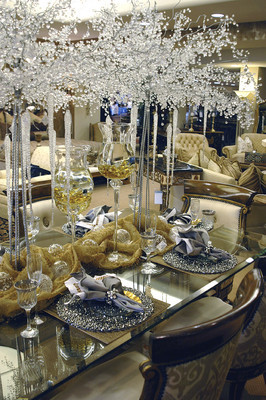Holiday setting

he calendar reads December and Jack Frost has begun nipping at our noses heralding the arrival of the holiday season. With it comes plenty of celebrations for family and friends, and there’s no better way to warm and welcome them than a festively set table.
Aside from getting out the special dishes that are only used once or twice a year, where should you begin?
Expert decorators suggest that before anything goes on the table, you select a theme or color scheme.
"You must have some kind of focal point or theme otherwise it’s not tabletop design, it’s just functional," said Lee Lundquist, an interior designer at Robb & Stucky in Las Vegas.
The theme or color scheme can be traditional, from the popular trends of the day or match the room’s décor, said Dalon Faulstick, director of Christmas for Paddock Pools.
"There are so many new designer colors that have popped into the Christmas world. It’s really a matter of what you want. If you want to go traditional, it doesn’t matter what colors are in your dining room, or you can take the colors in your dining room and create a tablescape based on those colors," he said.
"Having a consistent theme that runs through the tablescape, from settings to centerpiece, helps create a stronger point of view," agreed Melissa Nixon, visual director for Bloomingdale’s in Las Vegas.
As an example, she said if there are nutcrackers on your dinnerware, then you should incorporate nutcrackers in the centerpiece.
"Think of the direction your guests will be coming from and have centerpieces designed to suit. This way you get more bang for your buck," she added. "Don’t be afraid to have your presentation start in the back and cascade to the opposite end. This also puts your height in the rear and makes for unobstructed conversation."
For square and rectangular tables, another option to encourage conversation would be to create two centerpieces and place them on opposite corners.
Marcus Giannella, an interior designer with Robb & Stucky in Las Vegas, said a tablescape should complement the room’s dining room table and upholstery, and that hosts and hostesses should consider what elements they have when they begin creating their tablescapes.
"You don’t have to buy new china and linens and stemware, etc. Just add an accent," Nixon said, adding that could be something like a charger, decorative plate or napkin.
Faulstick, who teaches classes on holiday decorating as well as sets up all the stores’ displays, said he tells people to start simple. "When I talk to people, I tell them to start by picking out a couple of floral picks."
He said they should have mixtures of greens, such as pine and holly, as well as traditional holiday florals including poinsettias. They could even add pieces of fruit. "Take a few of those and put them in the center of the table with a couple of candles. It is gorgeous."
The trick to creating a successful tablescape is layers.
"Layering brings in softness along with functionality," said Lundquist.
"Layers add height and create drama. You really can’t have too many as long as you are consistent," Nixon said.
"Why not put an extra napkin below that plate? Not only does it give that pop of color you need, but it has a function. Maybe a guest needs an additional napkin between courses," she said.
As each layer is added, it is best to step back and look at the table to make sure it works or if something else needs be added, Giannella and Lundquist said, adding that each layer should also have a different color or texture.
Faulstick agreed.
"Even when I talk about decorating trees, I tell people not to use the same shape, size, texture. You always want to use different elements."
"In tabletops, I always like to have some form of fire and some form of glitz," said Giannella, who added that he also likes to create little elements of surprise. "It always has to say wow. Plus, I think it makes the food taste better."
Speaking of food, Faulstick said you probably should leave some space on the table for it.
"Something people tend to forget about when they build a tablescape is that they (guests) like to have a place to put the food when they sit down at the table," Faulstick said.
For that reason, he said he often designs "flat" tablescapes that allow guests to put their dishes directly on top of the décor. A piece of ribbon down the center of the table like a runner with a few candles on top of it will still look festive, he said. To complete the look, tie ribbons around the backs of the dining chairs.
Other ways to set the scene include replacing the art on the wall with festive holiday wreaths or using three small wreaths with candles in the centers to accent the adjacent buffet table or server.
"And if you have a hanging light or a chandelier, you can hang garlands from it or crystals to enhance the tablescape," Faulstick said.
As a final touch, Nixon says individualized place settings should be personalized for each guest.
"This is where the fun and imagination really come in. A small gift, such as an ornament for this time of year or champagne chocolates for New Year’s Eve, can make your guests feel special. Simply attaching their names with a tag can let them know you were thinking of them."












